| Article ID | Journal | Published Year | Pages | File Type |
|---|---|---|---|---|
| 10226075 | Mechanical Systems and Signal Processing | 2019 | 16 Pages |
Abstract
Wheel-soil interaction mechanics plays a crucial role for wheeled mobile robots (WMR) on rough and deformable terrains such as Martian and Lunar surfaces. Skid terramechanics is an essential component for WMRs and generates resistance force when a WMR brakes or on downhill slopes. The basis of classical terramechanics theories for WMRs - Bekker's normal stress and Janosi's shear stress equations - are so complex that the wheel-soil interaction force/torque equations are not amenable to closed form solutions, which seriously limits the application of terramechanics theories to WMRs. To establish analytical wheel-soil interaction expressions, the normal and shear stresses that can be characterized linearly by the proposed terrain stiffness and shear strength, respectively, are presented in this paper. Terrain stiffness and shear strength can be used to characterize terrain mechanical properties. Compared with the experimental data, the maximum relative error of the resistance forces estimated using these expressions at steady state is less than 7%. These validated expressions can be applied to estimate terrain parameters and resistance force online with high accuracy. Terrain's stiffness and shear strength increase first, and then reach a constant. Before wheels entering steady state, the online estimated resistance force's relative error is much higher, which can be explained using wheel's vertical velocity.
Keywords
Related Topics
Physical Sciences and Engineering
Computer Science
Signal Processing
Authors
Zhen Liu, Junlong Guo, Liang Ding, Haibo Gao, Tianyou Guo, Zongquan Deng,
